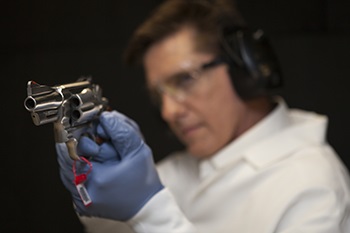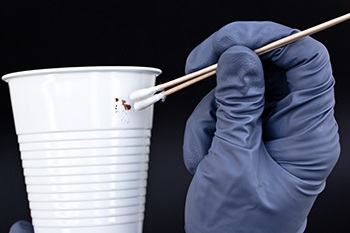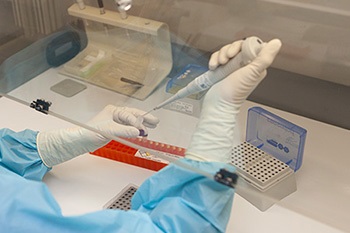The Tucson Police Department Crime Laboratory is part of the Forensics Division of the Investigative Services Bureau. Founded in 1960, it is the oldest crime lab in Arizona. In 2011, having outgrown its shared space at TPD Headquarters on South Stone Avenue, the Crime Lab moved into its own building at 1306 West Miracle Mile.
The Crime Lab employs 35+ people: a Crime Laboratory Superintendent, a Quality Assurance Coordinator, Unit Coordinators (including the DNA Technical Leader), Criminalists (I, II, III), a Detective, Police Evidence Examination Specialists, and a division Administrative Assistant. The Crime Laboratory Superintendent is Jelena Myers.
A Bachelor's Degree is required for most Crime Lab positions, preferably with a major in a physical science. New employees complete a training program and must demonstrate competency before they can independently perform forensic examination and analysis of evidentiary items. Each unit has its own training program, which can vary from one to two years. Employees must continue to demonstrate proficiency in their area of expertise in three core functions: forensic casework examination and analysis, reporting of results and conclusions, and expert witness court testimony.
For job opportunities at the Crime Lab, visit here. The Crime Lab does not offer internships, but volunteer opportunities may be available (visit https://tpdrecruiting.tucsonaz.gov/volunteers-interns).
For general inquiries, email CrimeLabMailbox@tucsonaz.gov.
In 1993, TPD's Crime Lab was one of the first municipal crime labs in the United States to gain national accreditation by the American Society of Crime Laboratory Directors-Laboratory Accreditation Board (ASCLD-LAB). Today, the lab is accredited by the ANSI National Accreditation Board (ANAB) Forensic Testing: ISO/IEC 17025:2017/AR 3125:2019.
The Crime Lab is a full-service facility with eight operational units:
- Firearms
- Forensic Biology (DNA)
- Latent Print Processing
- Latent Print Comparison
- Forensic Electronic Media
- Fire Debris
- Seized Drugs
- Toxicology (Blood Alcohol Analysis)
Firearms Unit

Firearms Unit
The Firearms Unit examines bullets and cartridge cases from crime scenes to determine if they can be linked to a specific firearm. If the firearm is not available, examination of the bullets and/or cartridge cases allows a determination of the type of weapon used—information which is often useful to the investigating detective. Comparisons are conducted using a comparison microscope that allows the examiner to view both the evidence sample and the test sample simultaneously.
Firearm Examiners also perform function tests, trigger pull measurements (the force required to fire the weapon), muzzle-to-target distance determinations, and serial number restorations.
Forensic Biology (DNA) Unit

Forensic Biology (DNA) Unit
The Forensic Biology Unit examines evidence for the presence of biological fluids and DNA. A complete copy of an individual’s DNA is found in most cells of the body. This DNA is extracted, amplified using Polymerase Chain Reaction, and analyzed.
Evidentiary items typically analyzed by the Forensic Biology Unit include biological fluids as well as items that may retain traces of biological fluids or human cells.
DNA profiles from evidentiary items are compared to buccal cells (cells from the inside of a cheek) or bloodstain standards from suspects and/or victims, or they may be searched through the FBI’s Combined DNA Index System (CODIS) database.
Latent Print Processing (LPP) Unit
The Latent Print Processing (LPP) Unit was formed in 2008 and became part of the Crime Lab in 2013. Latent prints are fingerprints, palm prints, or footprints from an unknown source which often require additional development using physical processes or chemistry and light. Latent Print Processors are responsible for detecting, collecting, and developing latent prints from crime scenes.
Most latent prints are collected using advanced photographic techniques. These examiners process evidence using visual, chemical, and physical methods, often collecting DNA from the items once the latent print examination is completed.
Latent Print Comparison (LPC) Unit

Forensic testing
The Latent Print Comparison (LPC) Unit became part of the Crime Lab in 2001. Officers and Crime Scene Specialists collect latent prints. Latent Print Examiners (LPEs) compare these latent prints to prints from known individuals in state and national fingerprint databases.
Forensic Electronic Media Unit (FEMU)
The Forensic Electronic Media Unit specializes in the collection, preservation, and analysis of digital evidence on computers, mobile devices, and digital video recorders (DVRs).
Fire Debris Unit
The Fire Debris Unit examines fire debris for the presence of ignitable liquids, such as gasoline.
Seized Drugs Unit
The Seized Drugs Unit analyzes tablets, powders, capsules, and unknown substances suspected of being dangerous drugs or narcotics. The Unit is also responsible for training officers on the use of field drug test kits.
Toxicology Unit
The Toxicology Unit analyzes blood samples for alcohol content, maintains TPD's Intoxilyzer instruments, and trains officers in their use.